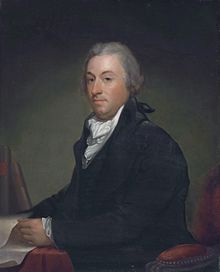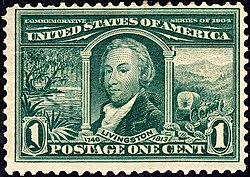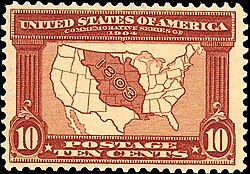| Revision as of 08:52, 21 April 2018 editInternetArchiveBot (talk | contribs)Bots, Pending changes reviewers5,388,413 edits Rescuing 1 sources and tagging 0 as dead. #IABot (v1.6.5)← Previous edit | Revision as of 16:04, 4 June 2018 edit undoGeo Swan (talk | contribs)Autopatrolled, Extended confirmed users, Pending changes reviewers112,843 edits disambiguationNext edit → | ||
| Line 65: | Line 65: | ||
| Livingston was a ], and in 1784, he was appointed the first ] of the ], retaining this title until 1801. The Grand Lodge's library in Manhattan bears his name. The Bible Livingston used to administer the oath of office to President Washington is owned by St. John’s Lodge No. 1, and is still used today when the Grand Master is sworn in, and, by request, when a President of the United States is sworn in. | Livingston was a ], and in 1784, he was appointed the first ] of the ], retaining this title until 1801. The Grand Lodge's library in Manhattan bears his name. The Bible Livingston used to administer the oath of office to President Washington is owned by St. John’s Lodge No. 1, and is still used today when the Grand Master is sworn in, and, by request, when a President of the United States is sworn in. | ||
| On July 4, 1786, he was part of the second group elected as honorary members of the New York ], along with Chief Justice ], Judge ], Continental Congressman ], and Justice ].<ref name="Schuyler1886">{{cite book|last1=Schuyler|first1=John|title=Institution of the Society of the Cincinnati : formed by the officers of the American Army of the Revolution, 1783, with extracts, from the proceedings of its general meetings and from the transactions of the New York State Society|date=1886|publisher=Printed for the Society by D. Taylor|location=New York|url=https://archive.org/details/societycincinnati00schurich/|accessdate=December 1, 2017}}</ref> | On July 4, 1786, he was part of the second group elected as honorary members of the New York ], along with Chief Justice ], Judge ], Continental Congressman ], and Justice ].<ref name="Schuyler1886">{{cite book|last1=Schuyler|first1=John|title=Institution of the Society of the Cincinnati : formed by the officers of the American Army of the Revolution, 1783, with extracts, from the proceedings of its general meetings and from the transactions of the New York State Society|date=1886|publisher=Printed for the Society by D. Taylor|location=New York|url=https://archive.org/details/societycincinnati00schurich/|accessdate=December 1, 2017}}</ref> | ||
| ==Personal life== | ==Personal life== | ||
Revision as of 16:04, 4 June 2018
| Robert Livingston | |
|---|---|
 | |
| United States Minister to France | |
| In office October 2, 1801 – November 18, 1804 | |
| Appointed by | Thomas Jefferson |
| Preceded by | Charles Pinckney |
| Succeeded by | John Armstrong |
| 1st Chancellor of New York | |
| In office July 30, 1777 – June 30, 1801 | |
| Governor | George Clinton John Jay |
| Preceded by | Position established |
| Succeeded by | John Lansing |
| 1st United States Secretary of Foreign Affairs | |
| In office October 20, 1781 – June 4, 1783 | |
| Appointed by | Congress of the Confederation |
| Preceded by | Position established |
| Succeeded by | John Jay |
| Personal details | |
| Born | (1746-11-27)November 27, 1746 New York City, New York, British America |
| Died | February 26, 1813(1813-02-26) (aged 66) Clermont, New York, U.S. |
| Political party | Democratic-Republican |
| Spouse(s) |
Mary Stevens (m. 1770; "his death" is deprecated; use "died" instead. 1813) |
| Relations | Edward Livingston (brother) Gertrude Livingston (sister) Robert Livingston (grandfather) |
| Children | Elizabeth Stevens Livingston Margaret Maria Livingston |
| Parent(s) | Robert Livingston Margaret Beekman |
| Alma mater | Columbia University |
Robert Robert Livingston (November 27, 1746 (Old Style November 16) – February 26, 1813) was an American lawyer, politician, diplomat from New York, and a Founding Father of the United States. He was known as "The Chancellor", after the high New York state legal office he held for 25 years. He was a member of the Committee of Five that drafted the Declaration of Independence, along with Thomas Jefferson, Benjamin Franklin, John Adams, and Roger Sherman.
Early life
Livingston was the eldest son of Judge Robert Livingston (1718–1775) and Margaret (née Beekman) Livingston, uniting two wealthy Hudson River valley families. He had nine brothers and sisters, all of whom wed and made their homes on the Hudson River near the family seat at Clermont Manor. Among his siblings was his younger brother, Edward Livingston (1764-1836), who also served as U.S. Minister to France, his sister Gertrude Livingston (1757–1833), who married Gov. Morgan Lewis (1754–1844), sister Janet Livingston (d. 1824), who married Richard Montgomery (1738–1775), sister Alida Livingston (1761–1822), who married John Armstrong, Jr. (1758–1843) (who succeeded him as U.S. Minister to France), and sister Joanna Livingston (1759–1827), who married Peter R. Livingston (1766–1847).
His paternal grandparents were Robert Livingston (1688–1775) of Clermont and Margaret Howarden (1693–1758). His great-grandparents were Robert Livingston the Elder (1654–1728) and Alida (née Schuyler) Van Rensselaer Livingston, daughter of Philip Pieterse Schuyler (1628–1683). His grand-uncle was Philip Livingston (1686–1749), the 2nd Lord of Livingston Manor. Livingston, a member of a large and prominent family, was known for continually quarreling with his relatives.
Livingston graduated from King's College in June 1765 and was admitted to the bar in 1770. King's College was renamed Columbia College of Columbia University following the American Revolution in 1784.
Career

In October 1773, Livingston was appointed Recorder of New York City, but soon thereafter identified himself with the anti-colonial Whig Party, and was replaced a few months later by John Watts, Jr.
From June 11, 1776, Livingston became a member of the "Committee of Five" that drafted the Declaration of Independence, although he was recalled by his state before he could sign the final version of the document. However, he sent his cousin, Philip Livingston, to sign the document in his place. (Another cousin, William Livingston, was a signer of the United States Constitution.)
Chancellor of New York
On July 30, 1777, Livingston became the first Chancellor of New York, which was then the highest judicial officer in the state. He became universally known as "The Chancellor", retaining the title as a nickname even after he left the office. Livingston was also U.S. Secretary of Foreign Affairs from 1781 to 1783 under the Articles of Confederation. In 1789, as Chancellor of New York, Livingston administered the presidential oath of office to George Washington at Federal Hall in New York City, then the Capital of the United States.
In 1789, Livingston joined the Jeffersonian Republicans (later known as the Democratic-Republicans), in opposition to his former colleagues John Jay and Alexander Hamilton who founded the Federalists. He formed an uneasy alliance with his previous rival George Clinton, along with Aaron Burr, then a political newcomer. He opposed the Jay Treaty and other Federalist initiatives.
In 1798, Livingston ran for Governor of New York on the Democratic-Republican ticket, but was defeated by incumbent Governor John Jay. He served as Chancellor until June 30, 1801.
U.S. Minister to France
Following Thomas Jefferson's election as President of the United States, once Jefferson became President on March 4, 1801, he appointed Livingston U.S. Minister to France. Serving from 1801 to 1804, Livingston negotiated the Louisiana Purchase. After the signing of the Louisiana Purchase agreement in 1803, Livingston made this memorable statement:
"We have lived long but this is the noblest work of our whole lives ... The United States take rank this day among the first powers of the world."
During his time as U.S. minister to France, Livingston met Robert Fulton, with whom he developed the first viable steamboat, the North River Steamboat, whose home port was at the Livingston family home of Clermont Manor in the town of Clermont, New York. On her maiden voyage she left New York City with him as a passenger, stopped briefly at Clermont Manor, and continued on to Albany up the Hudson River, completing in just under 60 hours a journey which had previously taken nearly a week by sloop. In 1811, Fulton and Livingston became members of the Erie Canal Commission.
Later life
Livingston was a Freemason, and in 1784, he was appointed the first Grand Master of the Grand Lodge of New York, retaining this title until 1801. The Grand Lodge's library in Manhattan bears his name. The Bible Livingston used to administer the oath of office to President Washington is owned by St. John’s Lodge No. 1, and is still used today when the Grand Master is sworn in, and, by request, when a President of the United States is sworn in.
On July 4, 1786, he was part of the second group elected as honorary members of the New York Society of the Cincinnati, along with Chief Justice Richard Morris, Judge James Duane, Continental Congressman William Duer, and Justice John Sloss Hobart.
Personal life
On September 9, 1770, Livingston married Mary Stevens (1751–1814), the daughter of Continental Congressman John Stevens and sister of inventor John Stevens III. Following their marriage, he built a home for himself and his wife south of Clermont, called Belvedere, which was burned to the ground along with Clermont in 1777 by the British Army under General John Burgoyne. In 1794, he built a new home called New Clermont, which was subsequently renamed Arryl House, a phonetic spelling of his initials "RRL", which was deemed "the most commodious home in America" and contained a library of four thousand volumes. Together, Robert and Mary were the parents of:
- Elizabeth Stevens Livingston (1780–1829), who married Lt. Governor Edward Philip Livingston (1779–1843), the grandson of Philip Livingston, on November 20, 1799.
- Margaret Maria Livingston (1783–1818), who married Robert L. Livingston (1775–1843), the son of Walter Livingston and Cornelia Schuyler, on July 10, 1799.
After his death, Livingston was buried in the Clermont Livingston vault at St. Paul's Church in Tivoli, New York.
Livingston family
Through his eldest daughter, he was the grandfather of four: Margaret Livingston (1808–1874), who married David Augustus Clarkson (1793–1874), Elizabeth Livingston (1813–1896), who married Edward Hunter Ludlow (1810–1884), Clermont Livingston (1817–1895), who married Cornelia Livingston (1824–1851), and Robert Edward Livingston (1820–1889), who married Susan Maria Clarkson de Peyster (1823–1910).
Legacy and honors
- Livingston County, Kentucky, and Livingston County, New York, are named for him.
- A statue of Livingston by Erastus Dow Palmer was commissioned by the state of New York and placed in the National Statuary Hall collection of the U.S. Capitol building, pursuant to the tradition of each state selecting two individuals from the state to be so honored.
- The Robert Livingston high rise building at 85 Livingston St. in Brooklyn, NY is named for him.
- In 1904, the U.S. Post office issued a series of postage stamps commemorating the 100th anniversary of the Louisiana Purchase along with the central figures involved in this historical transformation of the United States. The engraved image of Livingston is taken from a Gilbert Stuart (1783–1872) oil painting of 1794.
 |
 |
In popular culture
- In the 2008 HBO miniseries, John Adams, Livingston is portrayed by actor Alex Draper. Livingston also appears in the Broadway musical 1776, where he is appointed to the committee for drafting the Declaration of Independence. In the film version of the musical, he is played by actor John Myhers.
See also
Portals:References
- At the time, the Livingstons used their father's first name as a middle name to distinguish the numerous members of the family, as a kind of patronymic. Since he and his father had the same name, he never spelled out the middle name but always used only the initial.
- ^ Livingston, Edwin Brockholst (1910). The Livingstons of Livingston Manor: Being the History of that Branch of the Scottish House of Callendar which Settled in the English Province of New York During the Reign of Charles the Second; and Also Including an Account of Robert Livingston of Albany, "The Nephew," a Settler in the Same Province and His Principal Descendants. Knickerbocker Press. Retrieved August 10, 2017.
- "Livingston, Robert R. (1718–1775), [The Petition of Michael Theyser of the City of New York, Innkeeper]". www.gilderlehrman.org. The Gilder Lehrman Institute of American History. Retrieved September 11, 2016.
- www.kirkusreview.com
- Robert R. Livingston, Encyclopedia of World Biography.
- Schechter, Stephen L.; Tripp, Wendell Edward (1990). World of the Founders: New York Communities in the Federal Period. Rowman & Littlefield. ISBN 9780945660026.
- The Louisiana State Capitol Building Archived December 1, 2007, at the Wayback Machine
- Schuyler, John (1886). Institution of the Society of the Cincinnati : formed by the officers of the American Army of the Revolution, 1783, with extracts, from the proceedings of its general meetings and from the transactions of the New York State Society. New York: Printed for the Society by D. Taylor. Retrieved December 1, 2017.
- ^ The New York Genealogical and Biographical Record, Vol. XI. New York City: New York Genealogical and Biographical Society. 1880. Retrieved December 1, 2017.
- Yasinsac, Rob. "Arryl House". www.hudsonvalleyruins.org. Archived from the original on March 31, 2017. Retrieved December 1, 2017.
{{cite web}}: Unknown parameter|deadurl=ignored (|url-status=suggested) (help) - "Clermont State Historic Site: Imagining Arryl House: Piecing Together an Architectural Masterpiece". October 25, 2013. Retrieved December 1, 2017.
- "Obituary 1 -- No Title". The New York Times. December 14, 1898. Retrieved April 18, 2017.
- "Death of Edward H. Ludlow". The New York Times. November 28, 1884. Retrieved April 18, 2017.
- "G. LIVINGSTON DIES; LONG AN ARCHITECT; Practitioner Here for 50 Years Included Hayden Planetarium, Oregon Capitol in His Work". The New York Times. June 4, 1951. Retrieved June 6, 2017.
- "Mrs. Susan de Peyster Livingston". The New York Times. February 11, 1910. Retrieved June 6, 2017.
- Collins, Lewis (1877). History of Kentucky. p. 478.
- Clermont State Historical Site: http://clermontstatehistoricsite.blogspot.com/search?q=robert+livingston
Further reading
- Bonham, Jr., Milledge L. "Robert R. Livingston". in Samuel Flagg Bemis, ed. The American Secretaries of State and their diplomacy V.1 (1928) pp 115–92.
- Brecher. Frank W. Negotiating the Louisiana Purchase: Robert Livingston's Mission to France, 1801–1804 (McFarland, 2006)
- Dangerfield, George. Chancellor Robert R. Livingston of New York, 1746–1813 (1960)
- Chancellor Robert R. Livingston of New York Review of a 1960 biography by George Dangerfield
External links
- United States Congress. "Robert R. Livingston (id: L000372)". Biographical Directory of the United States Congress.
- The Chancellor Robert R Livingston Masonic Library of New York
- Louisiana purchase Risks and Rewards page
| Legal offices | ||
|---|---|---|
| Preceded byThomas Jones | Recorder of New York City 1773–1774 |
Succeeded byJohn Watts |
| New office | Chancellor of New York 1777–1801 |
Succeeded byJohn Lansing |
| Political offices | ||
| New office | United States Secretary of Foreign Affairs 1781–1783 |
Succeeded byJohn Jay |
| Diplomatic posts | ||
| Preceded byCharles Pinckney | United States Minister to France 1801–1804 |
Succeeded byJohn Armstrong |
| Envoys to France (1776–1779) |  | |
|---|---|---|
| Ministers Plenipotentiary to France (1778–1815) | ||
| Envoy Extraordinary and Minister Plenipotentiary to France (1816–1893) | ||
| Ambassador Extraordinary and Plenipotentiary to France (1893–present) | ||
| Erie Canal commissioners | |
|---|---|
(*) elected but declined; (**) elected but died before taking office |
- 1746 births
- 1813 deaths
- 19th-century American diplomats
- Ambassadors of the United States to France
- American Freemasons
- American people of Scottish descent
- Chancellors of New York (state)
- Columbia University alumni
- Continental Congressmen from New York (state)
- 18th-century American politicians
- Erie Canal Commissioners
- Livingston family
- New York City Recorders
- People of colonial New York
- Politicians from New York City
- United States Secretaries of State
- Lawyers from New York City
